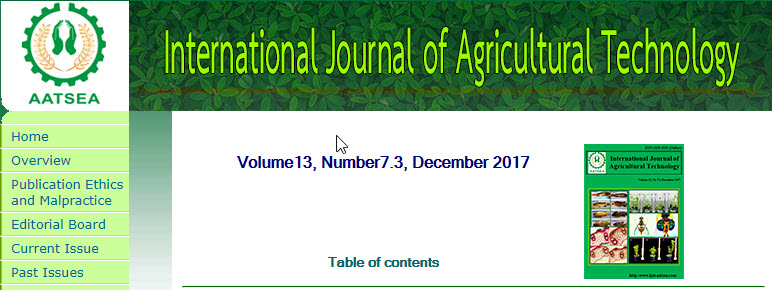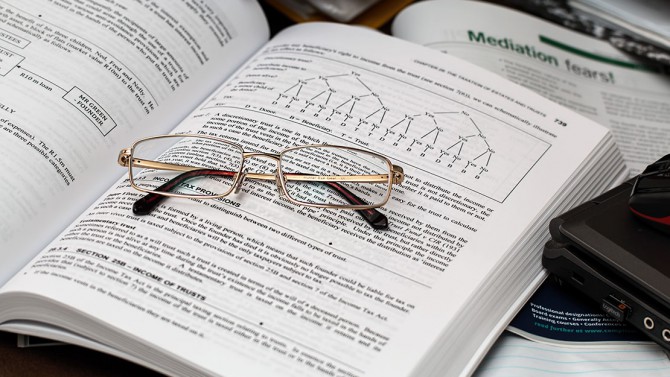

ผู้วิจัย
Bancherd sornsupharp Sairung Sonsupharp and Hans-Uwe Dahms
บทคัดย่อ
Digestibility efficiency of dry giant mimosa leaves pellet and skin colour were investigated in fancy carp and goldfish. The feed were included the basal feed (0 g. of giant mimosa; T1) and mixed with giant mimosa leaves of 50 g (T2), 100 g (T3), and 150 g (T4). Fancy carp and goldfish with an initial weight of 26.54±6.39 and 20.69±0.26 g were used for those experiments. Two groups’ fish were separated into the 70 litter aquarium glasses with 5 fish/aquaria and triplicate per treatment. Digestibility efficiency (DE) of trial feeds were investigated by indirect method. Skin colour of that fish was measured by the colour reader (Konica Minolta model CR10). The result showed that different consequence DE in fancy carp and goldfish. Fancy carp displayed that significant difference (p0.05). However, the b* value showed the difference in the final time. That fish fed with T3 had higher value than the other with 37.71±0.28. The chromaticities of that fish were slight changed from initial to final time. These researches concluded that dry giant mimosa leaves meal can use in fancy fish and goldfish up to 100 g kg-1 with not affect to DE. Moreover, the skin colour in term of L*, a* and b* showed high value in that fish fed with 100 g kg-1 dry giant mimosa leaves.
บรรณานุกรม
Association of Official Analytical Chemists (AOAC). (2000). Official methods of analysis of AOAC International. Association of Official Analytical Chemists, Gaithersburg, 2200pp. Bandyopadhyay, P. Swain, S.K. and Mishra, S. (2005). Growth and dietary utilization in goldfish (Carassius auratus Linn.) fed diets formulated with various local agro-produces. Bioresource Technology 96: 731–740. Cho, C.Y. (1993). Digestibility of feedstuffs as a major factor in aquaculture waste management. In: Fish Nutrition in Practice. IVth International Symposium on Fish Nutrition and FeedinBiarritz, France, June 24–27, 1993. pp. 365–374, INRA, Paris, France. Cho, C.Y., Slinger, S.J. and Bayley, H.S. (1982). Bioenergetics of salmonid fishes: Energy intake, expenditure and productivity. Comparative Biochemistry and Physiology Part B 73: 25-41. CIE. (1976). Official Recommendations on Uniform Colour Space, Colour Difference Equations and Metric Colour Terms. Suppl. No. 2 to CIE Publication No.15, Colorimetry.Commission International del’ Eclairage, Paris. Davis, D.A. and Arnold, C.R. (1994). Estimation of apparent phosphorus availability from inorganic phosphorus sources for Penaeus vannamei. Aquaculture 127(2–3): 245-254. Degani, G., Viola, S. and Yehuda, Y. (1997a). Apparent digestibility coefficient of protein sources for carp, Cyprinus carpio L. Aquaculture Research 28(1): 23–28. Degani, G., Yehuda, Y. and Viola, S. (1997b). The digestibility of nutrient sources for common carp, Cyprinus carpio Linnaeus. Aquaculture Research 28(8): 575-580. El-Shafai, S. A., El-Gohary, F. A., Verreth, J. A. J., Schrama, J. W. and Gijzen, H. J. (2004). Apparent digestibility coefficient of duckweed (Lemna minor), fresh and dry for Nile tilapia (Oreochromis niloticus L.). Aquaculture Research 35 (6): 574-586. Fagbenro, OA. (1999). Use of full fat winged bean Psophocarpus tetragonolobus seed meal as a protein feedstuff in fish meal diet for African catfish Clarias gariepinus. Aquaculture Nutrition 5: 199–204. Fujii, R. (2000). The regulation of motile activity in fish chromatophores. Pigment Cell Research 13: 300-319. Kelsh, R.N. (2004). Genetics and Evolution of Pigment Patterns in Fish. Pigment Cell Research








ความคิดเห็น